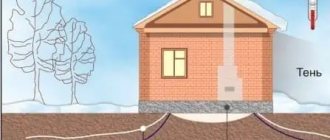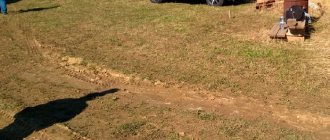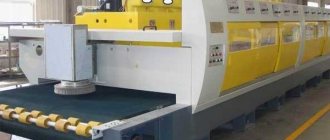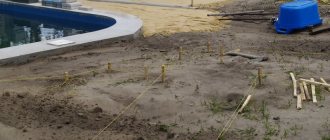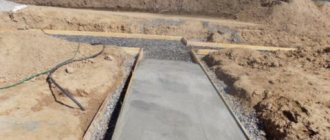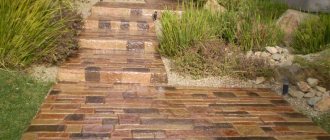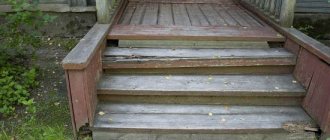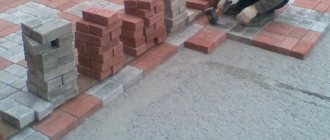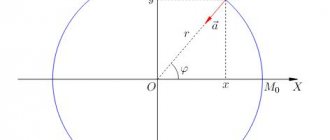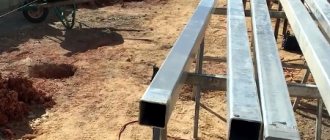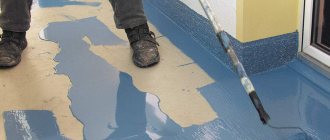Pouring concrete in the yard for car parking
A properly organized concrete pad in the yard will preserve the neat appearance of the dacha plot, protect lawns from tire marks, and make car parking comfortable, convenient and reliable. Before you start concreting the parking lot, you need to choose building materials and a place for it:
- Materials for construction. Unlike paving stones or paving slabs, between which weeds will begin to grow over time, concrete is the most suitable material. It is wear-resistant, strong and durable, and also quite easy to use and affordable. Pouring concrete in this case is most preferable.
- Parking lot. The location should be chosen at a level higher than the general area in order to provide for water flow, incl. rain. If the site falls on communication networks, then it is necessary to provide protection for them: boxes, cases, etc. It is not worth choosing a place close to the house, because... The temperature difference negatively affects the properties of concrete and can cause its deformation.
By connecting the finished parking lot, for example, using curbs or gutters, with the entrance to the garage and adjacent paths, you can give the look of the site completeness.
Important! It is recommended to fill in during the daytime and during the warm season.
Types of sites, how to calculate depending on the type of car
Parking areas in the yard are made from different materials. The following types of parking are common:
- Concrete.
The most reliable, although somewhat more complex than others in the device.
- Lawn (grass).
The easiest option is to simply park the car on the lawn. You can additionally mark the parking area with pegs or tires. However, this option is very unreliable. Wheel marks will be visible on it, and in rainy weather there will be a lot of dirt.
- Bulk.
It is filled with gravel, pebbles, granite chips or crushed stone. Materials of medium or fine fraction are selected (but so as not to clog into the tread). A fairly durable option. The device involves formwork and careful leveling of the material.
- Tiled.
Quite a durable option with a long service life. They look neat, but over time the look can be spoiled by grass growing between the tiles.
- Ecotextile.
The device is relatively simple: a layer of ASG (about 15 cm) is covered with geotextiles, onto which lawn honeycombs are fixed on top. They are filled with soil containing the seeds of the future lawn. They have a more pleasant appearance in contrast to lawn areas.
The area of the parking lot should be sufficient for maneuvers. When calculating the size of a future parking lot, it is advisable to focus on the standards adopted in SNiP and GOST: the dimensions of the site for a passenger car are at least 3x6 m, for a truck - 4x11 m.
Primary requirements
Before starting work, you need to take into account the basic requirements for parking. Their size in the yard is determined depending on the number of cars. The placement of transport must be free. Site size for one car:
- length - 5 m;
- width - 3 m.
READ How to tie reinforcement for a strip foundation
A parking space is installed near the gate or next to it. To prevent rainwater from stagnating in the parking lot, the site should not be in a low area.
The base is laid at a slight slope of 2-5°, then the water will drain completely. If you install gutters along the edges of the parking lot, rainwater will flow in the right direction.
Preparing the base for pouring a concrete pad
Before pouring a concrete area for parking a car in the yard, the base must first be prepared: mark the boundaries of the future parking lot, as well as clean and level the surface.
The main stages of constructing a concrete platform:
- preparation work;
- foundation organization;
- formwork installation;
- reinforcement;
- preparation of solution;
- concreting.
Composition of the mixture, how to calculate how much is needed
To concrete the site, you need to prepare a solution.
Materials you will need:
- Concrete. You should choose a brand no lower than M300, or better yet, M400 or M500.
- Water. About two times less than cement.
- Gravel, crushed stone. Without impurities and other debris, fraction – 1-2 centimeters.
- Sand. Should not contain clay impurities, because it can destroy concrete.
- Cement. With a high degree of resistance to moisture and frost.
The required thickness of concrete for a platform for a car depends not only on the weight of the car, but also on other existing loads. It is recommended to determine this indicator by referring to the technical instructions of GOST. A layer of at least 10-15 cm is considered optimal. According to the standards, you can select, including the thickness of the concrete, for a truck. The volume of the solution is determined by multiplying the depth, length and width of the base. The proportions are calculated from the fact that cement-sand-crushed stone/gravel-water is taken per 10 m3: 1: 2: 4: 0.5.
The components are mixed in a concrete mixer, where cement and water are first added, then sand, and lastly gravel/crushed stone.
Use of concrete
Compared to paving stones, concreting a site is a budget option when arranging a parking lot. Step-by-step work plan:
- first, select and prepare the area for concreting, then lay the cushion;
- install beacons and formwork;
- carry out metal reinforcement of the base;
- prepare the solution and then pour it.
Preparing the site and material
To properly fill the area with concrete for the car, you need to prepare the area. The selected area to be concreted is marked with pegs. They are driven into the corners of the site, and a cord is pulled between them. Before you concrete the area for the car with your own hands, you should carefully level the area. Otherwise, due to small dimples on the surface, the structure of the screed will be constantly disrupted. And to lay the screed, you will need additional material, which will lead to extra costs. The following tools and materials will be needed:
- frost-resistant cement under the F200 brand;
- water and sand;
- metal profile;
- fittings;
- boards;
- building level.
The area is cleared of grass and debris, and the ground is thoroughly compacted. A sand and gravel cushion is created before or after the installation of formwork. The sequence of work is determined by the master. The first layer is sand, the second is crushed stone. Each layer is 10 cm.
The layers are leveled, moistened and compacted thoroughly. To ensure high-quality water drainage, the site is poured at a slight slope.
Formwork design and installation of beacons
Installation of formwork is necessary to give the screed the required shape, since it is impossible to pour cement mortar on a flat surface without this structure. To prevent the solution from spreading and solidify reliably, the area to be poured is surrounded by wooden walls. Each of them is secured with pegs. The optimal concrete thickness for a platform for a car is 15 cm. There is no need for additional reinforcement of the formwork, since such a layer of mortar does not exert much pressure on the structure.
READ Types and calculation of reinforced concrete floor beams
Beacons are a plasterboard profile . They are attached to a cement-sand mortar laid out in small slides. The metal profile is pressed into these slides. During work, use a level. Any horizontal surface is concreted with the help of beacons holding wooden boards. The sequence of their installation:
- Round metal pins (rods) are installed in each corner. Notches are made on them.
- Then, at the level of the notches, a thread is pulled between the pins. Each knitting of the thread is checked with a level.
- In the middle of the stretched threads, 2 transverse landmarks are made.
- Beacons are installed in those places where the threads come into contact with each other.
- The distance between the beacons must be at least 50 cm.
Foundation reinforcement
When arranging a parking lot for a car, it is necessary to reinforce the base, since the concrete structure will be better strengthened with reinforcement. This can be done in two ways:
- The easiest way is to purchase a ready-made lattice at a hardware store.
- Create your own lattice by tying metal rods with wire. The diameter of the rods is chosen up to 10 mm.
A movable frame is created from metal rods by laying them lengthwise and crosswise. The intersection points are tied with wire. Welding is not used in the manufacture of the frame, otherwise it will become immobile. And this will lead to deformation of the foundation. In order for the reinforcement to get inside the concrete screed, it must be located 2 cm above the gravel layer. To do this, the reinforcement is installed on supports.
READ How much does a reinforced concrete sleeper weigh and what are its dimensions?
How to make a parking lot with your own hands, step-by-step instructions
Even those who have no experience in this can make a car parking lot on their own property with their own hands. The main thing here is to know the sequence of necessary work and strictly follow it. To install a concrete parking lot you need:
- prepare the surface;
- install formwork;
- strengthen the structure by reinforcement;
- pour concrete.
Important! If cracks appear in the parking lot during use, they are rubbed down with ordinary cement mortar.
Surface preparation
Preparatory measures for organizing parking for a car in the yard include:
- marking the boundaries of the area where concrete will be poured;
- removal of weeds and debris;
- preparing a pit - excavating soil at least 20 cm deep to get rid of the roots of weeds and prevent their subsequent germination;
- installing a sand cushion of about 15 cm, which must be leveled, thoroughly compacted and slightly moistened;
- filling a crushed stone layer of at least 10 cm, leveling and compacting;
- geotextile flooring to prevent the pillow from spreading under the load from the solution.
Important! It is necessary to ensure that the site slopes in one direction (or two) so that water from washing the car or rain drains away.
Installation of formwork
Before pouring concrete into the future site, it is necessary to arrange removable formwork to create smooth edges. This can be done using plywood, iron, boards, curb stones or plastic, fastening the fences together. The formwork is installed before the sand cushion is filled in to prevent the solution from leaking out. To level the solution, it is recommended to use beacons with a pitch of 50 cm, which are suitable as metal pins. Notches are made on them to determine how smooth the surface is, and a cord is secured between them along the notches. The check is carried out at the building level.
Reinforcement
To increase the strength of a concrete platform, it is necessary to perform reinforcement. The reinforcement frame is a mesh of metal rods 0.8-1 cm in diameter, fastened with wire. The reinforcement process consists of laying the frame on a layer of sand and crushed stone.
Filling the parking lot
The prepared concrete solution is poured onto the site and carefully leveled along the beacons. You can level the composition with any flat strip or special tool. Filling is done in one go, so when mixing, you need to make a volume that will be used up immediately.
Important! Do not pour the solution when the outside temperature is below 5°C.
Base reinforcement
Before starting the reinforcement process, it is necessary to lay crushed stone on the sand cushion (it will be enough to make a layer of 5-8 centimeters), and then compact it thoroughly.
Reinforcing bars will strengthen the concrete structure, so it is not recommended to ignore this stage. This important procedure can be performed in two ways. In the first, it is supposed to knit metal rods using wire according to the honeycomb principle. The second technology is much simpler - it is the installation of a special grille, which can be purchased at any hardware store.
The use of the second option is suitable for sites where it is planned to park no more than two cars, that is, in a parking lot that will not be subject to heavy loads. Actually, this is why reinforcement and wire can be used to fill the foundation. It is advisable to make the frame directly on site.
The rods are laid crosswise, and at the junction they are tightly tied with wire. As for welding work, experts do not recommend doing this, since during welding the structure loses its mobility. This may cause deformation, which in turn will damage the reinforcing base.
READ Features of pouring concrete floors in a private house
